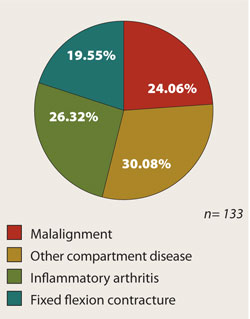Patient selection is crucial in patellofemoral arthroplasty, surgeon says
KOLOA, Hawaii — Proper patient selection can ensure the success of patellofemoral arthroplasty, according to an orthopedic specialist from Georgia.
“Patellofemoral arthroplasty is rare, but it is one of my favorite operations because it works pretty well,” said Ormonde M. Mahoney, MD, at Orthopedics Today Hawaii 2011, here. He said his presentation was particular to one patellofemoral component (Avon Patello-Femoral Joint Replacement, Stryker), but his results apply to all of the newer devices that are available today from multiple manufacturers.
Mahoney said his indications for patella replacement are patients with grade 4 chondromalacia, which is present in 5% to 8% of arthritic knees.
Contraindications
His contraindications include: inflammatory arthritis, leg malalignment, tibiofemoral disease, patellar baja and fixed flexion contracture.
“If you put it into someone who is having these problems, they are going to be disappointed and so are you,” he said, noting that he is very selective of appropriate patients for the device.
According to Mahoney, published reports by the developer of the device show good results with a failure rate of approximately 5%.
Approach
Mahoney said he likes to use the subvastus approach. “Tracking is one of the prime sources of problems, so you should medialize the patellar button to enhance the tracking and externally rotate the femoral component.”
In his practice, Mahoney has performed about 30 of these during a 4-year period. “I had three failures, one of them had inflammatory arthritis — I had made the classic mistake.”
One of the biggest problems with patellofemoral implants is when they are put in a little valgus, which raises the lateral edge of the prosthesis. “It is the biggest and most basic mistake. When the knee goes from flexion to extension the patellofemoral joint is loaded and so there are compressive forces across the patella and, if you rotate that femoral component, then the lateral edge will become proud and the component will hang on it.”
He said this is a great operation to perform, although a little counterintuitive. “We don’t use the patellofemoral joint that much. It is just along for the ride for most of the activites of daily living, so these devices, although they are high-stressed, really are not subjected to a lot of mileage.” – by Lee Beadling
Reference:
- Mahoney OM. Patellar replacement: Indications and longevity. Presented at Orthopedics Today Hawaii 2011. Jan. 16-19. Koloa, Hawaii.
Disclosure: Mahoney is a paid consultant for Stryker.

Attendees were asked: What are your contraindications for patellofemoral arthroplasty? Here are the results from the audience response system:
![]() Follow ORTHOSuperSite.com
on Twitter
Follow ORTHOSuperSite.com
on Twitter


